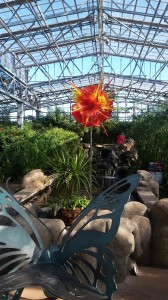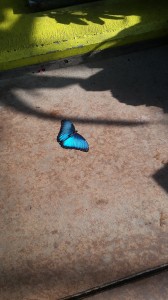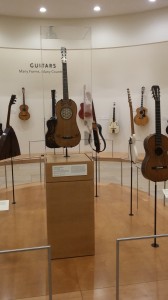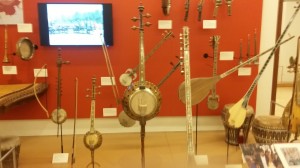A VISIT TO WESTERN ARIZONA – BUTTERFLYS AND BANJOS
A VISIT TO WESTERN ARIZONA
This is the first in a series of articles about visiting Western Arizona
BUTTERFLYS AND BANJOS
By Charles N Stevens
Photos by Dolores Seidman
I didn’t know what to expect at a place called Butterfly Wonderland located in Scottsdale, a classy Phoenix suburb.
Soon after our arrival we are ushered into a small theater where they will show us a 3-D film about Monarch Butterflies. These large orange butterflies migrate from Canada and the northern United States to a particular forest in Mexico where they gather by the thousands on the trees. The film traces this unbelievable migration. As the film is 3-D, it appears that we are surrounded by the Monarchs. Some of us are waving away butterflies that come close to our faces even though we know they are not really there. We really feel we are among them. We follow them all the way to their destination, that special forest in Mexico where they alight on the trees and turn them bright orange with the colors of their wings. Unfortunately this forest is in danger as poor farmers are cutting down some of the trees to make enough money to put food on the table.
From the theater, we walk to a Butterfly Emergence Gallery, where hundreds of cocoons hang on racks in a large glassed in incubator of sorts. This is their butterfly hatchery. It’s fascinating to look at the cocoons as some are absolutely still while others move with the struggle of the butterfly attempting to emerge. Butterflies have completely emerged from some of the cocoons and are resting after their ordeal of freeing themselves.
We move on then to the heart of the museum, the huge glass and steel atrium where butterflies are free to fly in a controlled atmosphere similar to that of the tropics. We are dazzled by the size of the atrium, but mostly by the numbers and varieties of butterflies flying around inside. Over forty two types of butterflies from all parts of the world, most brilliantly colored , are free to fly anywhere in the space of the museum. The most striking butterfly to me is a Blue Morpho from the tropics, a large butterfly with beautiful bright blue wings. But all of them are spectacular with their various colors and shapes. Cameras click everywhere as people hope to capture all that beauty and preserve it. The butterflies often land on the tropical trees and shrubs, on the sidewalks and walls, even on people, to the delight of the children who are chosen.
Butterfly Wonderland is perfect for kids and adults. It is more than a place to see pretty butterflies. It’s a working museum built on solid science and designed to enrich learning.
Not far from the Butterfly Wonderland is another first class museum, the Musical Instrument Museum, displaying almost every instrument known. The instruments are arranged according to the country or part of the world where they were created and where they represented the culture of that area. The top floor displays instruments from Africa and the Middle East through every part of Asia to Latin America and Oceania. Of course, there is a large collection of instruments from Europe as well as Canada and the United States. The instruments are attractively displayed and organized. What I thought was an outstanding feature was the flat-screened television accompanying each display. With a touch of a button we could see and hear the instruments being played on the screen by the people of that particular country. Most interesting to me was the clip of a gamelon “band”, a series of different sizes of metal drums or containers that the players struck softly in their special sound. It reminds me of our trip to Indonesia where we often heard them, and saw women dancing gracefully to their rhythm.
The museum opened in 2010 and is the largest museum of its type in the world. It contains over 6,800 musical instruments representing 200 countries and territories. Guests are provided with free headsets to use as they explore the displays and listen to the music. On the museum’s lower floor is a 300 seat performance space, an award-winning restaurant and a well-stocked museum store.
And don’t miss the instruments played by such notables as Elvis Presley, Taylor Swift and Johnny Cash.

A huge atrium gives ample space for the butterflies to roam.

One of the most beautiful butterflies is the Blue Morpho shown here.

Guitars of all types are arranged in attractive displays.

Banjos and banjo-like instruments fill another display case.
MONTEREY PARK AUTHOR PUBLISHES 4th BOOK – Seeking More of the Sky: Growing Up in the 1930’s:
Charles “Norm” Stevens, a 43 year resident of Monterey Park has recently published his 4th book: Seeking More of the Sky: Growing Up in the 1930’s. This is the story of a young boy growing up in Inglewood, California in the l930’s. This was a time during the depression when unemployment was affecting many and the banks were closed, while the clouds of war were gathering in Europe. But he was lucky enough to be raised in a loving family, the power of that love reflected throughout his stories.
Stevens is the author of three previous books about his experiences during WWII:
An Innocent at Polebrook: A Memoir of an 8th Air Force Bombardier (Story of his 34 bombing missions from his base at Polebrook, England over Germany and France)
The Innocent Cadet: Becoming A World War II Bombardier (A prequel to the first, telling of his training in the U.S. before going overseas into combat.)
Back from Combat: A WWII Bombardier Faces His Military Future from Combat: (This book details the time from when he returned from combat in England until the end of the war.)
He is known to the readers of The Citizen’s Voice as the author of Travel Log Articles including “Cruising the Rhine and Mosel”,” Best of the West”, “In Search of Snow” , “From Paris to Normandy on the Seine”, and “Exploring New York”. He is retired, having taught for 32 years, primarily in the Montebello Unified School District.
Those interested in purchasing an autographed copy of any of his books, may contact the author at 323-721-8230 or Normstevens24@gmail.com.



